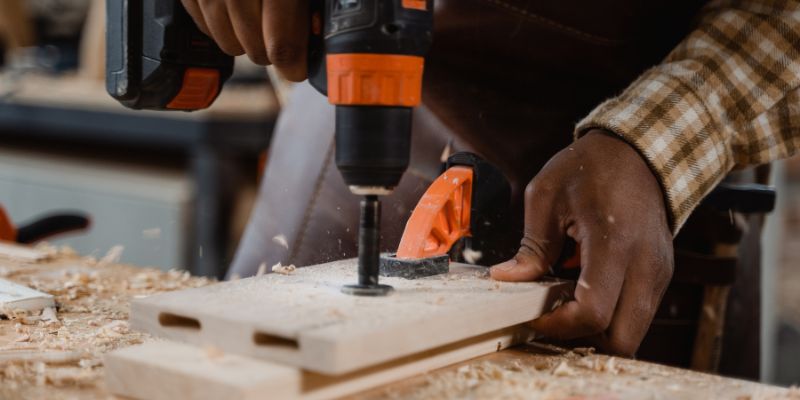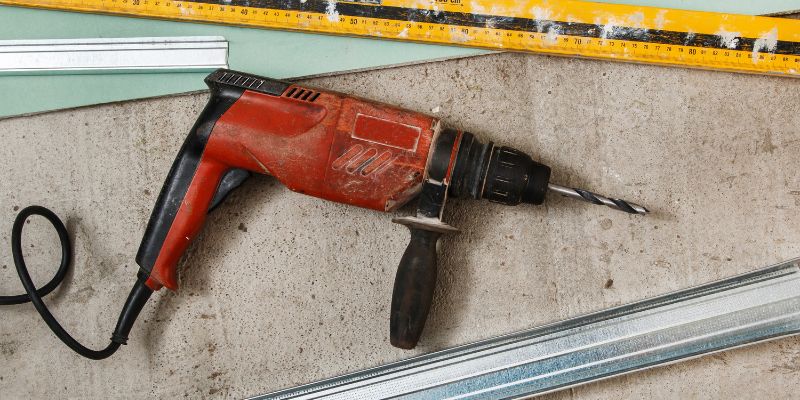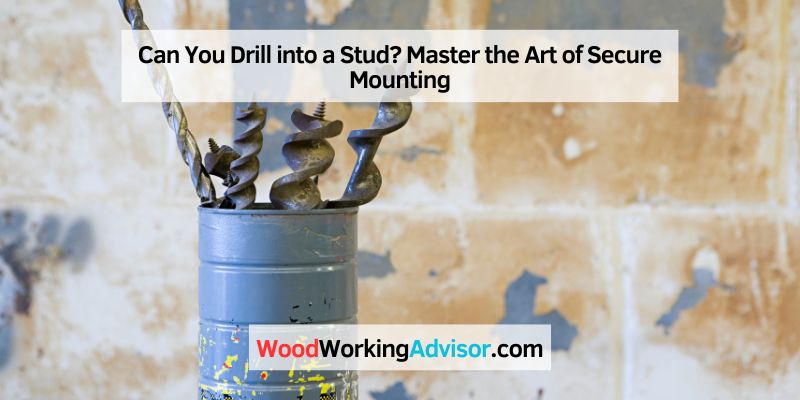Yes, you can drill into a stud. Drilling into a stud provides a secure anchor point for various purposes such as hanging heavy objects or installing shelves.
When considering drilling into a stud, it is important to locate the stud accurately to ensure stability and prevent damage to the structure. Using a stud finder can help identify the stud’s position. Once located, mark the spot and use an appropriate drill bit to create the hole.
Remember to use caution and select the right tools to ensure a successful and safe drilling experience.
Importance Of Secure Mounting
Secure mounting is crucial to ensure the stability and safety of your fixtures, and drilling into a stud is essential for this task. By utilizing proper tools and techniques, you can effectively anchor items to the wall, preventing potential accidents or damage.
This method provides peace of mind and long-term support for mounted objects.
Preventing Accidents
One of the primary reasons why secure mounting is so important when drilling into a stud is to prevent accidents. When you hang heavy fixtures, such as shelves or mirrors, on a wall, you want to ensure that they remain securely in place. A loose mounting can result in these fixtures falling and causing injuries or damage to the surrounding area. By drilling into a stud, you’re able to provide a strong foundation for your fixtures, reducing the risk of accidents occurring.
Ensuring Longevity Of Fixtures
Another crucial aspect of secure mounting is the impact it has on the longevity of your fixtures. When you properly anchor your fixtures into a stud, you create a stable support system that can withstand the test of time. This prevents unnecessary wear and tear on the fixtures and helps to maintain their structural integrity. Without secure mounting, fixtures may become loose over time and require frequent repairs or replacements, leading to additional expenses and inconvenience.
In addition to preventing accidents and ensuring the longevity of fixtures, secure mounting also provides peace of mind. Knowing that your fixtures are securely mounted gives you the confidence that they will remain in place, even under heavy loads. It allows you to decorate or organize your space without worry, knowing that your fixtures are reliably supported by the wall.

Understanding Studs And Their Role
When it comes to home improvement projects, it’s important to have a solid understanding of studs and their role in the construction of your walls. Studs are vertical framing members that provide support and stability to your walls, acting as a backbone for the entire structure. In this blog post, we will explore what studs are, their importance in mounting objects on walls, and whether it is possible to drill into a stud.
What Are Studs?
Studs, often made of wood or metal, are the vertical beams that form the frame of your walls. They are usually positioned at regular intervals, typically 16 or 24 inches apart, and extend from the bottom plate to the top plate of the wall. The space between the studs is filled with insulation, wiring, and plumbing, providing a protective enclosure for various utilities within your walls.
Importance In Mounting
Mounting heavy objects on your walls can be a challenging task. However, studs play a crucial role in ensuring that whatever you hang or attach to the wall stays securely in place. Studs offer significant support and can bear more weight than other parts of the wall, such as drywall or plaster. By attaching your wall-mounted items, such as shelves, cabinets, or TVs, directly to the studs, you can avoid potential damage to your walls and ensure a long-lasting and sturdy mount.
In addition to providing stability, studs also give you the flexibility to place your mounts wherever you desire. By identifying the stud locations in your wall, you can strategically position your mounts and avoid any weak areas that could compromise the stability of your installation. However, it is crucial to locate the center of the stud accurately to ensure proper anchoring and avoid damaging any pipes or electrical wiring within the wall.
To locate studs, you can use a stud finder, a handheld device that detects changes in density within the wall. Alternatively, you can also look for subtle clues, such as electrical outlets, light switches, or trim, which are often mounted directly onto the studs. By making use of these clues, you can minimize the risk of drilling into empty spaces between the studs and maximize the sturdiness of your mount.
While mounting objects on studs is generally the preferred method, it is essential to consider the weight and size of the object you plan to hang. For heavier items, it may be advisable to distribute the weight across multiple studs or even consider additional support options, such as using toggle bolts or anchor screws in conjunction with the studs.
Understanding the role of studs in mounting objects is essential for ensuring the stability and durability of your wall installations. By utilizing these vertical framing members effectively, you can confidently drill into studs, knowing that your mounted objects will remain secure and your walls will stay intact.
Tools And Techniques For Drilling Into Studs
Tools and Techniques for Drilling into Studs is an essential skill for any DIY enthusiast or professional. Choosing the Right Drill Bit, and Best Practices for Drilling are crucial aspects to consider when working with studs. Let’s explore the tools and techniques to ensure safe and effective drilling into studs.
Choosing The Right Drill Bit
When drilling into studs, selecting the correct drill bit is paramount. Using a wood drill bit is optimal for wood studs, while a metal drill bit is suitable for metal studs. Ensure the bit is compatible with the material to prevent damage and achieve clean and precise holes.
Best Practices For Drilling
Adhering to best practices is vital for successful drilling into studs. Some key tips include:
- Marking the drilling spot with a pencil for accuracy
- Using a stud finder to locate the center of the stud
- Applying steady pressure and using a slow speed to avoid splintering
- Using a depth stop to prevent drilling too deep into the stud
Alternative Mounting Options
The process of drilling into a stud can be a bit daunting for some homeowners. Whether you’re hanging up shelves, installing a TV mount, or any other project that requires a secure anchor, it’s important to consider alternative mounting options. In this section, we will explore two effective alternatives to drilling into a stud: using anchors and mounting on drywall. These options will provide you with the stability you need while avoiding potential damage to your walls.
Using Anchors
When drilling into a stud is not possible or practical, using anchors is a great alternative. Anchors are devices that provide additional support and stability when hanging objects on drywall or materials that are not as sturdy as studs. They work by expanding and gripping the material, creating a secure hold.
There are various types of anchors available, each suitable for different weights and applications. Here are some common anchor options:
- Metal Toggle Bolts: These heavy-duty anchors are ideal for hanging heavier items, such as mirrors or shelves. They consist of a two-part mechanism that expands behind the drywall, providing strong support.
- Plastic Expansion Anchors: These anchors are perfect for lightweight applications, such as hanging picture frames or small decorations. They expand when a screw is inserted, creating a tight grip on the wall.
- Molly Bolts: Ideal for medium-weight objects, such as towel bars or curtain rods, Molly bolts provide reliable support. They require a larger hole during installation, but the metal sleeve and screw ensure a secure connection.
Before using anchors, it’s important to read the manufacturer’s instructions carefully and choose the right anchor for your specific application. Using anchors can help distribute weight evenly and prevent damage to your walls.
Mounting On Drywall
If you’re unable to locate a stud or prefer not to drill into one, mounting directly on drywall is another alternative worth considering. However, it’s important to note that drywall is not as sturdy as a stud, so caution should be taken when mounting heavier items.
When mounting on drywall, it’s crucial to use appropriate hardware, such as picture hooks or drywall anchors. These fixtures are designed to provide support in drywall without the need for a stud. Here are some tips for mounting on drywall:
- Choose the right type of hanging hardware or anchors based on the weight of your object.
- Ensure that the anchor or hardware is installed securely in the drywall, following the manufacturer’s instructions.
- Avoid overloading the anchor or hardware with excessive weight.
- Spread the weight evenly across the anchor or multiple anchors to prevent damage.
By following these tips and using proper hardware, you can successfully mount items on drywall without the need for drilling into a stud.

Securing Heavy Fixtures
When it comes to securing heavy fixtures, such as shelves, mirrors, or cabinets, it’s essential to have a strong and sturdy anchor point. One of the most common methods for securing fixtures is by drilling into a stud. A stud is a vertical wooden beam behind the drywall, providing solid support for mounting heavy items. However, it’s crucial to understand the proper strategies for maximum support and when it’s necessary to seek professional help.
Strategies For Maximum Support
If you are planning to mount a heavy fixture, following these strategies will help ensure maximum support:
- Locate the Stud: Before drilling into a stud, you need to locate it accurately. Use a stud finder tool or tap the wall lightly to listen for a solid sound that indicates a stud’s presence. Once found, mark the edges of the stud with a pencil or painter’s tape.
- Preparation is Key: Prepare the necessary tools and materials before drilling. You will need a drill, appropriate drill bit, screwdriver or screw gun, screws, and wall anchors if required. Ensuring you have everything ready beforehand will minimize potential mistakes or delays.
- Measure Twice, Drill Once: Take precise measurements and double-check them before drilling. Ensure the fixture is level and aligned by using a measuring tape or level. This extra step will save you from the headache of re-drilling and adjusting later on.
- Choose the Right Hardware: Selecting the correct screws or wall anchors is essential for securing heavy fixtures. The length and gauge of the screw should be appropriate for the weight of the fixture. If unsure, consult hardware store professionals for expert guidance.
- Proper Installation Technique: When drilling into a stud, make sure to use the correct drill bit size to prevent splitting the wood. Start with a smaller pilot hole and gradually increase the size to accommodate the screw. Drive the screw into the stud firmly but avoid overtightening, as it may damage the stud or strip the screw’s thread.
When To Seek Professional Help
While securing heavy fixtures can be a DIY project for many, some situations warrant the expertise of a professional. Consider seeking professional help for the following scenarios:
- Structural Concerns: If you notice any signs of structural damage or weakness in your walls, it’s best to consult a professional before drilling into them. They can evaluate the situation and recommend appropriate solutions to ensure the safety of your fixtures and the integrity of your walls.
- Electrical Wiring and Plumbing: If you are uncertain about the location of electrical wiring or plumbing pipes within the wall, it is crucial to consult a professional. Accidentally drilling into these can lead to costly damages and potential hazards.
- Complex Installations: Some heavy fixtures require additional support or specialized installation techniques. If you are dealing with complex fixtures like heavy-duty shelves, large mirrors, or cabinets, it may be wise to hire a professional who has experience in dealing with these types of installations.
Frequently Asked Questions Of Can You Drill Into A Stud
Is It Okay To Drill Into A Stud?
Yes, it is okay to drill into a stud. Drilling into a stud provides a strong anchor point for things like shelves or wall hangings. Always use a stud finder to locate the stud and choose the appropriate drill bit and screws for the job.
How Do You Drill A Hole In A Stud?
To drill a hole in a stud, follow these steps:
1. Mark the desired spot on the stud.
2. Use a drill bit appropriate for the size of the hole you need.
3. Securely hold the drill perpendicular to the stud.
4. Apply steady pressure and drill through the stud.
5. Remove the drill and debris, and you’re done!
Why Can’t I Drill Through Stud?
You can’t drill through a stud because it’s a load-bearing vertical framing member in a wall. It provides structural support for the building. Drilling into a stud can weaken the wall and compromise its integrity. Use a stud finder to locate studs and avoid drilling into them.
How Do You Know If You’re Drilling Into A Stud?
To know if you’re drilling into a stud, use a stud finder or tap the wall to listen for a solid sound. Look for clues like electrical outlets or light switches, as they are often attached to studs. Additionally, measure the distance between studs, typically 16 or 24 inches apart.
Conclusion
Knowing how to properly drill into a stud is essential for any DIY home improvement project. By following the proper steps and utilizing the right tools, you can successfully drill into a stud without causing damage or compromise to the structural integrity of your walls.
With the right techniques, you can handle this task with confidence and ensure a safe and secure result.


